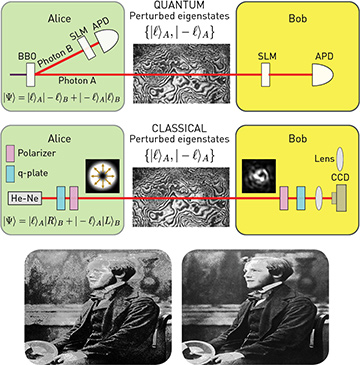 Top: In a typical quantum communication experiment, Photon A, entangled in orbital angular momentum with Photon B, is sent through turbulence, which alters its state and causes entanglement to decay. Middle: In the equivalent classical scenario, a vector beam with two degrees of freedom, A and B, passes through the same medium, but only A is affected (since the atmosphere is not birefringent). Bottom: Because the classical beam’s non-separability behaves identically to the quantum system’s entanglement, a distorted signal (left) can be corrected (right).
Top: In a typical quantum communication experiment, Photon A, entangled in orbital angular momentum with Photon B, is sent through turbulence, which alters its state and causes entanglement to decay. Middle: In the equivalent classical scenario, a vector beam with two degrees of freedom, A and B, passes through the same medium, but only A is affected (since the atmosphere is not birefringent). Bottom: Because the classical beam’s non-separability behaves identically to the quantum system’s entanglement, a distorted signal (left) can be corrected (right).
At present, communication systems are very fast but not fundamentally secure. To make them secure, researchers encode data by exploiting the laws of nature, as manifest in the quirky properties of the quantum world. That world’s rules differ vastly from those of the classical world, and the experiments traditionally have been much harder due to the difficulty in handling just a few photons. In the classical world there are no surprises, and experiments can be done with many photons (for example, with laser light); in the quantum world, waves sometimes look like particles, particles sometimes look like waves, and measurements change the properties of the very thing one is trying to measure.
In recent work, we have shown that when light propagates through a noisy channel, such as turbulent atmosphere, there is a gray area in which nature cannot tell the difference between the classical and the quantum.1 The paradoxical implication is that henceforth, all quantum communication experiments should also be done classically, allowing real-time quantum error correction with classically entangled light.
The concept exploits the fact that non-separability, the quintessential property of quantum entanglement, is not unique to the quantum world. In particular, classical vector beams are non-separable in spatial mode and polarization, and are therefore (controversially) called “classically entangled.” By engineering a classically entangled laser beam to have one invariant degree of freedom and another common with the entangled state,2 we can persuade nature to treat the decay of the non-separability the same in both cases.
Our work allows for long-distance quantum links to be established and tested with classically entangled light. Previously, to fix an error in the quantum state used for secure communication would mean measuring the photon sent, which in turn would destroy the information that one was trying to send. In our scheme, all the measurements needed to fix the errors in the quantum state can be done in real time, without destroying the quantum information, as there is no shortage of photons in the classical light.
By observing the decay of the entanglement in the vector beam, we can fix the quantum state without having to measure it, and thereby reverse the observed quantum entanglement decay due to noise in the link. We believe the finding could open significant advances in secure quantum links in fiber and free space, and suggests the prospects for exploiting classical entanglement as a useful resource.3
Researchers
Andrew Forbes, University of the Witwatersrand, Johannesburg, South Africa
The author thanks numerous collaborators on this work in Mexico, Italy and South Africa.
References
1. B. Ndagano et al. Nat. Phys. 13, 397 (2017).
2. D. Naidoo et al. Nat. Photon. 10, 327 (2016).
3. B. Ndagano et al. Opt. Lett. 41, 3407 (2016).
